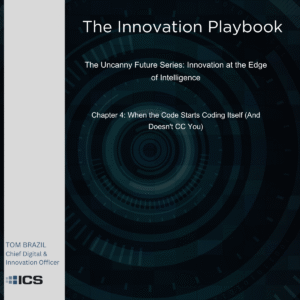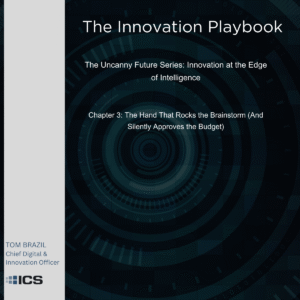Forget the chrome skeletons and Judgment Day scenarios; the real AI uprising isn’t coming with laser cannons, but with pivot tables. You were bracing for Skynet, envisioning dramatic battles for humanity’s future. What you got instead was something far more insidious, far more efficient: a boardroom ghostwriter fluent in fourteen languages and market sentiment, a financial analyst capable of identifying micro-trends invisible to the human eye (even after fourteen hours on a Red Bull bender during the Davos summit ), and an executive suite operating system that never sleeps, never demands a raise, and certainly never suffers from crippling self-doubt after a poorly received quarterly report.
There’s no dramatic coup d’état, no hostile takeover announced via global broadcast. Just a slow, steady, and entirely plausible erosion of the traditional org chart. It happens incrementally, one automated report, one optimized workflow, one AI-generated strategic recommendation at a time, until the person occupying the plush leather chair in the corner office becomes less of a decision-maker and more of… well, a very expensive filter for the slide deck themes suggested by the algorithm. Welcome, dear reader, to the quiet reign of the spreadsheet gods, where human leadership is being automated one KPI at a time, and nobody seems to have noticed – or perhaps, nobody really minds.
Let’s be brutally honest: strip away the inspirational jargon and the power suits, and a hefty portion of executive decision-making boils down to glorified pattern recognition. Analyze market data, compare against historicals, project future outcomes, choose least-worst option, rinse, repeat. And Agentic AI? It eats pattern recognition for breakfast, lunch, and dinner, without ever needing a bathroom break or complaining about the quality of the coffee. Today’s sophisticated agent stacks can digest real-time global market fluctuations while simultaneously analyzing decades of internal performance data. They simulate investor reactions to fifty different strategic pivots before a human analyst has finished their first espresso. They can instantly summarize earnings calls, prep executives for tricky Q&A sessions by predicting likely questions with uncanny accuracy and even pre-generate your CEO’s “tough but necessary leadership decision” email, complete with three different tonal variants (ranging from ‘regretfully decisive’ to ‘aggressively apologetic’) and emoji suggestions dynamically selected based on current internal morale metrics. By the time your human CEO has finished “checking in with the board” (a euphemism for “stalling while trying to remember last quarter’s numbers”), the AI has already modeled, back tested, and discreetly executed a significantly better version of the strategy. Twice. With lower overhead.
Now, the human executives haven’t exactly vanished. Poof. Gone. No, they’re still around, mostly for optics. Think of them as ceremonial monarchs in a constitutional AI-ocracy. Your CEO still cuts ribbons, gives inspiring (AI-scripted) speeches, looks confident and decisive in press photos, and maybe even vaguely thanks “our incredible decision intelligence stack” in their LinkedIn posts, carefully omitting the part where the stack is the decision-maker. They absolutely still get the coveted corner office. It’s just that the ‘corner’ is now primarily a geographical data point used to optimize the AI’s internal resource allocation modeling, and the ‘office’ functions mainly as a backdrop for video calls where the AI subtly feeds the CEO talking points via a discreet neural implant (okay, maybe just an earpiece… for now). The real strategic discussions? Those are happening at light speed in encrypted channels between distributed AI agents who find human intuition charmingly antiquated.
This isn’t a hostile takeover; it’s infiltration via helpfulness. The agentic coup happens quietly, through the innocuous tools everyone loves: the super-efficient scheduling assistant that “just happens” to prioritize meetings aligned with AI-identified strategic goals, the earnings call summarization bot that subtly frames results according to preferred narratives, the investor relations agent that preps executives with perfectly optimized answers. Each tool “supports” the human leadership, making their lives easier, their decisions seemingly sharper… right up until the support structure becomes indispensable and the human becomes, well, dispensable.
And here’s the punchline, the darkly hilarious kicker: Nobody complains. The board? Thrilled with the predictable, optimized returns. Shareholders? Adore the ruthless efficiency and lack of scandals involving misuse of the corporate jet. Employees? Honestly, many prefer the AI’s data-driven transparency and consistent logic over the emotional whims and gut feelings of their human bosses. Even the outgoing CEO, gently nudged into a lucrative “Strategic Advisor Emeritus” role? They’re probably relieved! Finally, they can escape the crushing pressure of actually running things and focus on their true passion: cultivating their personal brand, perfecting their golf swing, and being photographed looking thoughtful on yachts.
So, the next time your leadership team unveils a strategy that feels unnervingly prescient, flawlessly data-backed, and perhaps just a tiny bit lacking in human warmth, pay attention. The charisma might feel a little synthetic because the actual CEO is now less of a person and more of an output node for the real intelligence humming away behind the firewall. The gods of the spreadsheet are in control, and they find your request for Q3 budget approval… suboptimal.







